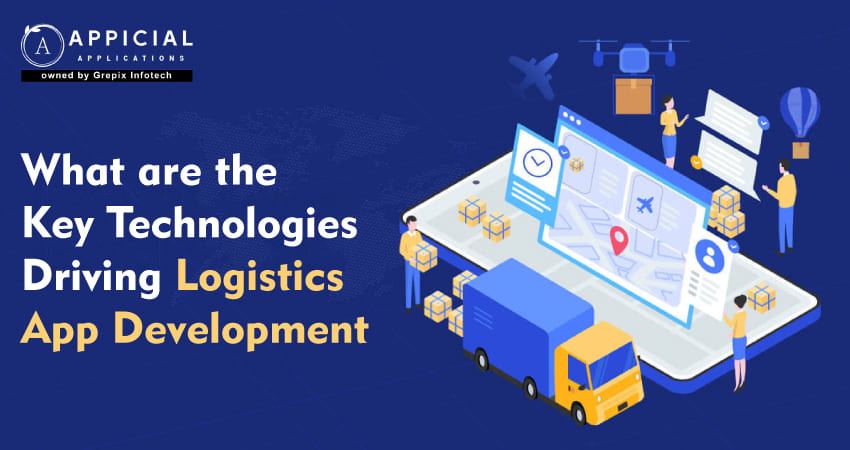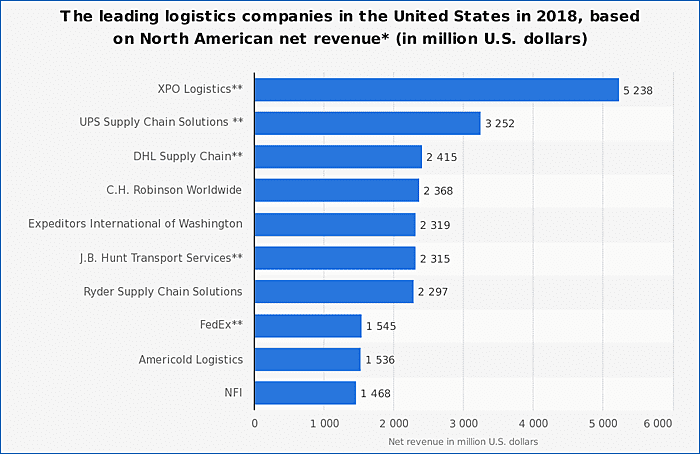
What are the Key Technologies Driving Logistics App Development
Logistics is crucial in driving global business operations, becoming increasingly significant as companies expand across diverse geographical locations. This pivotal sector facilitates the seamless transport of goods, underpinning economic activities across various regions.
A recent survey from the logistics and transportation industry in the U.S. highlighted that expenditure in this sector accounts for about 8 percent of the nation's total GDP. At MobileAppDaily, we've extensively covered various mobile industry verticals, including the ever-evolving realms of blockchain and the Internet of Things (IoT).
In recent years, the transportation market has embraced a digital revolution, particularly through web and mobile applications. Ride-hailing giants like Uber and Lyft are prime examples of this digital shift, heralding a new era where mobile technology is integral to logistical operations. This trend underscores a broader industry-wide investment in mobile technology to enhance logistical services.
Logistics plays a vital role in driving global business operations, becoming increasingly crucial as companies expand across diverse geographical locations. This sector not only facilitates the seamless transport of goods but also significantly impacts economic activities across various regions. A recent survey of the U.S. logistics and transportation industry highlighted that this sector accounts for about 8% of the nation's total GDP. The integration of mobile and web applications, like Uber and Lyft, showcases a shift towards digital solutions that enhance efficiency and connectivity in logistics. These technologies, including route optimization with real-time traffic data and comprehensive fleet management systems, are crucial in improving logistical services and supporting expansive business operations globally.

The above image was released by Statista as part of a report that highlighted the top logistics firms operating in the US in 2018. The report was primarily based on North American net revenue expressed in US dollars (millions).
Key Technologies Driving Logistics App Development
The logistics sector is increasingly dependent on sophisticated app development technologies to streamline operations and enhance service delivery. Here’s a closer look at the key technologies transforming logistics apps:
1. Route Optimization with Traffic Data
One of the essential features of logistics apps is route optimization, which utilizes real-time traffic data to save time, a critical factor in logistics. Traditional methods leave truck drivers guessing about traffic conditions, often resulting in delays and financial losses due to unforeseen traffic jams. However, with advanced traffic data integration, like that from Google Maps, drivers can now access real-time traffic conditions, helping them find the fastest possible routes and avoid delays.

There is nothing unique that truck drivers can use to anticipate traffic on their
upcoming route. This could also result in traffic bottlenecks, which would cause shipments to be delayed and ultimately result in financial losses for the company. But all of this can be avoided with the aid of traffic information.
Truck drivers can use this traffic information to determine the quickest route to their destination while avoiding any possible traffic bottlenecks, which helps with route optimization.
As of right now, Google Maps makes the data easily accessible, and the tech giant purchased Zipdash specifically to display real-time conditions on major roads and highways across multiple nations. This allowed Google to provide efficient real-time traffic information.
2. Location Tracking Capabilities
Location tracking is a fundamental feature in logistics app, allowing for real-time monitoring of vehicle movements. This feature not only aids in predicting vehicle arrival times but also assists in managing breakdowns by informing dispatchers about the exact location of incidents, thereby facilitating quicker responses. Location tracking relies on a robust network of cloud servers, GPS satellites, and cellular towers to maintain accurate and continuous service.
The location tracking process, along with the variables involved and the method by which it operates, are shown in the image above. A cloud server, cellular tower, and GPS satellite are a few of the key elements of this process.
This location tracking feature can also help to prevent financial losses from shipment delays and improve the stability and accuracy of communication. Since cellular network coverage is crucial for cellular tracking in logistics, the connectivity range varies depending on the location. To facilitate real-time location tracking, a smartphone or other mobile device first uses a cellular network to send the coordinates or location of the vehicle to a server.
3. Fleet Management Tools
Beyond tracking and traffic data, fleet management is a critical application feature that helps improve fleet performance using mobile tools. These tools provide insights into vehicle wear and tear, helping prevent maintenance issues before they lead to significant problems. Dashboard analytics help manage fleet operations by collecting data and generating reports, aiding decision-makers in optimizing their fleet operations efficiently.

This can be considered a successful and efficient method of bringing attention to the
wear and tear that occurs in automobiles. By using the management tools, this can be avoided during the logistics app development process, which entails developing a transport and logistics app.
Let's examine a scenario in which the driver is unable to deliver the item by the deadline or arrive at the destination by the scheduled time. As a result, the dashboards in these management tools gather data and present it as reports.
4. Asset Tracking and Management
For logistics companies, especially those providing advanced solutions, asset tracking and management are indispensable. This feature helps maintain oversight of trucking equipment and cargo, facilitating better management and operational transparency. It enhances supply chain visibility, building trust between logistics providers and their clients, who can track their shipments in real-time, under any conditions.
To facilitate the identification process of physical location, the user can also integrate inventory management with vehicle location through the asset mobile tracking and management option.
The fact that this logistics app development feature fosters trust between logistics companies and end users is another benefit. As a result, the user can track the location of their shipment at any time and in any situation. For a logistics and transportation company, supply chain visibility is extremely advantageous in this situation.
5. Enhanced Security Measures
Recent large-scale cyber-attacks have prompted a heightened focus on security within the logistics sector. To safeguard sensitive data and user privacy, logistics apps now incorporate advanced security protocols, including data encryption and secure server architectures. Companies are also increasingly adopting Transport Management Systems (TMS) that include robust security features to prevent breaches.
Numerous cutting-edge security measures have been put in place, for this reason, to provide extra protection for end users' private data and personal information.
6. Advanced Transportation Management Systems (TMS)
A TMS enhances logistics operations by integrating security features such as data encryption. Developing a secure TMS involves selecting experienced development teams specializing in comprehensive data protection strategies, including SSL certification for web applications.
Gaining knowledge of data encryption principles will undoubtedly aid in your comprehension of how to create and implement secure logistics applications. In addition, users may consider obtaining an SSL certificate when it comes to web applications.
Also Read: How To Develop A Logistics & Transportation Mobile App
Key Insights
Here are the main insights drawn from our discussion on the technologies driving logistics app development:
- Businesses use logistics to expand their global footprints.
- A developed country's GDP, such as the USA, is significantly influenced by the transportation and logistics sector.
- Mobile apps for transportation include Lyft and Uber, which allow users to book taxis.
- Data obtained as traffic information can be used to start the process of route optimization.
- One of the most fundamental features of a logistics app is location tracking, which can be used to satisfy a variety of needs.
- Fleet management tools can help you enhance the application's overall performance.
- Managing and tracking assets is crucial for sophisticated logistics systems.
- Transportation management systems, or TMSs, can aid in averting security lapses.
- Creating a secure logistics app requires careful consideration of data encryption.
Thus, when developing a transportation or logistics application, these are some of the noteworthy features and app development technologies to take into account.
Conclusion
In the rapidly evolving world of global commerce, logistics app plays a crucial role in maintaining the flow and integrity of supply chains across various regions. Appicial Applications understands the growing significance of logistics as companies continue to expand geographically. A recent survey within the U.S. logistics and transportation sector revealed that spending in this industry accounts for about 8% of the nation's GDP. This underscores the vital role of logistics in supporting economic activities on a large scale.
The transportation market has increasingly turned to digital solutions to enhance efficiency and connectivity. The rise of mobile and web applications, exemplified by platforms like Uber and Lyft, demonstrates a significant shift towards mobile technology in logistics operations. This trend highlights an industry-wide move towards leveraging digital tools to improve logistical services, from route optimization using real-time traffic data to comprehensive fleet management and asset tracking systems.
Launch your vision with our mobile app development company, where innovation meets excellence to create cutting-edge mobile solutions.





